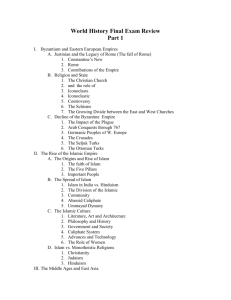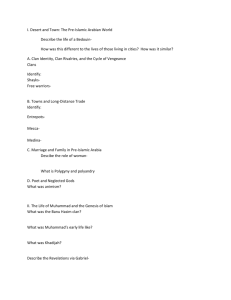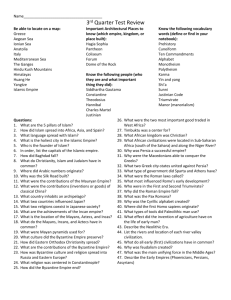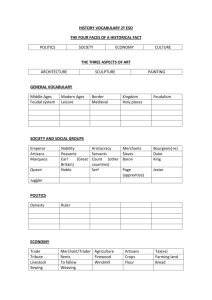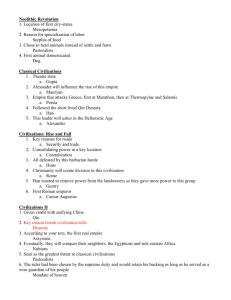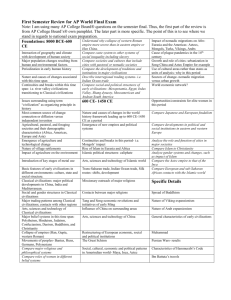7th grade Social Studies Curriculum Map 1st Nine Weeks
advertisement
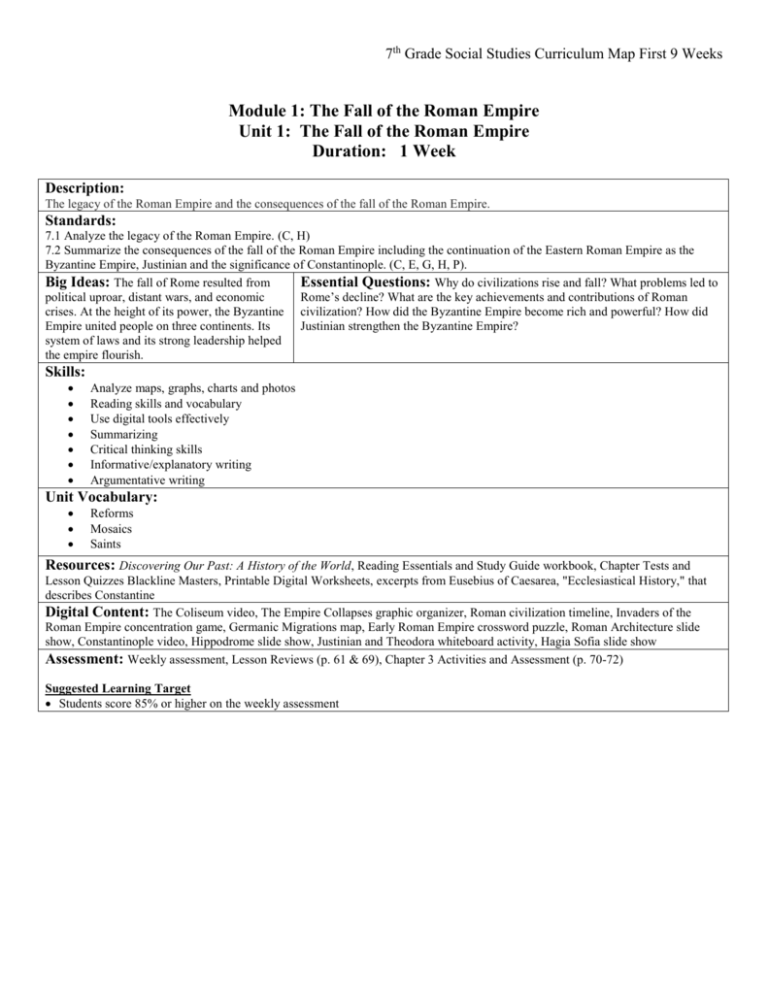
7th Grade Social Studies Curriculum Map First 9 Weeks Module 1: The Fall of the Roman Empire Unit 1: The Fall of the Roman Empire Duration: 1 Week Description: The legacy of the Roman Empire and the consequences of the fall of the Roman Empire. Standards: 7.1 Analyze the legacy of the Roman Empire. (C, H) 7.2 Summarize the consequences of the fall of the Roman Empire including the continuation of the Eastern Roman Empire as the Byzantine Empire, Justinian and the significance of Constantinople. (C, E, G, H, P). Big Ideas: The fall of Rome resulted from Essential Questions: Why do civilizations rise and fall? What problems led to political uproar, distant wars, and economic Rome’s decline? What are the key achievements and contributions of Roman crises. At the height of its power, the Byzantine civilization? How did the Byzantine Empire become rich and powerful? How did Empire united people on three continents. Its Justinian strengthen the Byzantine Empire? system of laws and its strong leadership helped the empire flourish. Skills: Analyze maps, graphs, charts and photos Reading skills and vocabulary Use digital tools effectively Summarizing Critical thinking skills Informative/explanatory writing Argumentative writing Unit Vocabulary: Reforms Mosaics Saints Resources: Discovering Our Past: A History of the World, Reading Essentials and Study Guide workbook, Chapter Tests and Lesson Quizzes Blackline Masters, Printable Digital Worksheets, excerpts from Eusebius of Caesarea, "Ecclesiastical History," that describes Constantine Digital Content: The Coliseum video, The Empire Collapses graphic organizer, Roman civilization timeline, Invaders of the Roman Empire concentration game, Germanic Migrations map, Early Roman Empire crossword puzzle, Roman Architecture slide show, Constantinople video, Hippodrome slide show, Justinian and Theodora whiteboard activity, Hagia Sofia slide show Assessment: Weekly assessment, Lesson Reviews (p. 61 & 69), Chapter 3 Activities and Assessment (p. 70-72) Suggested Learning Target Students score 85% or higher on the weekly assessment 7th Grade Social Studies Curriculum Map First 9 Weeks Module 2: Islamic World, 400 A.D/C.E. – 1500s Unit 1: The Islamic Faith Duration: 1 Week Description: Students analyze the geographic, political, economic, social, and religious structures of the Islamic civilizations. Standards: 7.3 Identify the physical location and features and the climate of the Arabian Peninsula, its relationship to surrounding bodies of land and water, including Northern Africa, Mediterranean Sea, Black Sea, Caspian Sea, Tigris and Euphrates Rivers, Nile River. (G) 7.5 Trace the origins of Islam and the life and teachings of Muhammad, including Islam’s historical connections to Judaism and Christianity. (C, H) 7.6 Explain the significance of the Qur’an and the Sunnah as the primary sources of Islamic beliefs, practice, and law and their influence in Muslims’ daily life. (C, H, P) Big Ideas: Islam is one of the most widely Essential Questions: How did physical geography influence the Arab way of practiced religions in the world. Approximately life? What message did Muhammad preach to the people of Arabia? How does 25 percent of the people in the world are Islam provide guidance to its followers? Muslim. Skills: Analyze maps, graphs, charts and photos Reading skills and vocabulary Use digital tools effectively Critical thinking skills Summarizing Research Comparing and contrasting Unit Vocabulary: Islam Oasis Sheikh Caravans Quran Shari’ah Resources: Discovering Our Past: A History of the World, Reading Essentials and Study Guide workbook, Chapter Tests and Lesson Quizzes Blackline Masters, Printable Digital Worksheets, excerpts from The Hadith, Muhammad; excerpts from The Book of Golden Meadows, Masoudi, Geography and History Activity worksheet Digital Content: Islamic World video, Bedouin Life slide show, Sacred Muslim Sites slide show, the Kaaba diagram Assessment: Weekly assessment, Lesson Review (p. 107), Chapter 3 Activities and Assessment (p. 120-121) Suggested Learning Target Students score 85% or higher on the weekly assessment 7th Grade Social Studies Curriculum Map First 9 Weeks Module 2: Islamic World, 400 A.D/C.E. – 1500s Unit 2: The Spread of Islam Duration: 1 Week Description: Students analyze the geographic, political, economic, social, and religious structures of the Islamic civilizations. Standards: 7.4 Describe the expansion of Muslim rule through conquests and the spread of cultural diffusion of Islam and the Arabic language. (C, E, G, H) 7.7 Analyze the origins and impact of different sects within Islam, Sunnis and Shi’ites. (C, H) 7.9 Describe the establishment of trade routes among Asia, Africa, and Europe and the role of merchants in Arab society. (E, G, H) 7.11 Explain the importance of Mehmed II the Conqueror and Suleiman the Magnificent. (H, P) 7.12 Write an explanatory text to describe the Shah Abbas and how his policies of cultural blending led to the Golden Age and the rise of the Safavid Empire. (C, H, P) Big Ideas: The religion of Islam continues to Essential Questions: How did the Arabs spread Islam and create an empire? influence modern politics and society. How did the Arab Empire change after the Umayyads? How did the Turks, Safavids, and Moguls rule their empires? Skills: Analyze maps, graphs, charts and photos Reading skills and vocabulary Use digital tools effectively Argumentative writing Comparing Informative/explanatory writing Making presentations Unit Vocabulary: Caliph Sunni Shia Sultan Resources: Discovering Our Past: A History of the World, Reading Essentials and Study Guide workbook, Chapter Tests and Lesson Quizzes Blackline Masters, Printable Digital Worksheets, excerpts from The Hadith, Muhammad; excerpts from The Book of Golden Meadows, Masoudi Digital Content: Islamic Trade Routes video, Spread of Islam map, The Four Caliphs chart, Islamic Architecture slide show Assessment: Weekly assessment, Lesson Review (p. 114), Chapter 3 Activities and Assessment (p. 120-121) Suggested Learning Target Students score 85% or higher on the weekly assessment 7th Grade Social Studies Curriculum Map First 9 Weeks Module 2: Islamic World, 400 A.D/C.E. – 1500s Unit 3: The Islamic World Duration: 1 Week Description: Students analyze the geographic, political, economic, social, and religious structures of the Islamic civilizations. Standards: 7.8 Examine and summarize the contributions Muslim scholars made to later civilizations in the areas of science, geography, mathematics, philosophy, medicine, art, and literature. (C, G, H) 7.10 Gather relevant information from multiple print and digital sources to examine the art and architecture, including the Taj Mahal during the Mughal period. (C, H) Big Ideas: Muslim advances in mathematics, Essential Questions: How did people live and trade in the Islamic world? business, science, architecture, and the arts What were Muslim contributions in math, science, and the arts? helped to create our modern society. Skills: Analyze maps, graphs, charts and photos Reading skills and vocabulary Use digital tools effectively Summarizing Research Critical thinking Comparing and contrasting Making presentations Informative/explanatory writing Unit Vocabulary: Mosques Bazaar Astrolabe Minarets Resources: Discovering Our Past: A History of the World, Reading Essentials and Study Guide workbook, Chapter Tests and Lesson Quizzes Blackline Masters, Printable Digital Worksheets, excerpts from The Hadith, Muhammad; excerpts from The Book of Golden Meadows, Masoudi Digital Content: Islamic Scientific Advances video, Mosques slide show, The Rubaiyat primary source Assessment: Weekly assessment, Lesson Review (p. 119), Chapter 3 Activities and Assessment (p. 120-121) Suggested Learning Target Students score 85% or higher on the weekly assessment 7th Grade Social Studies Curriculum Map First 9 Weeks Module 3: Africa, 400 A.D./C.E. – 1500s Unit 1: Rise of African Civilization Duration: 1 Week Description: Students analyze the geographic, political, economic, social, and religious structures of African civilizations. Standards: 7.13 Analyze the growth of Ghana, Mali, and Songhai kingdoms including trading centers such as Timbuktu and Jenne, which would later develop into centers of culture and learning. (C, E, G, H, P). 7.14 Draw evidence from informational texts to describe the role of the trans-Saharan caravan trade in the changing religious and cultural characteristics of West Africa and the influence of Islamic beliefs, ethics, and law. (C, E, G, H, P) Big Ideas: The geography of Africa affected Essential Questions: How did early peoples settle Africa? How did trade the development and interaction of civilizations develop in Africa? Why did West African trading empires rise and fall? How did all over the huge continent. trade affect the development of East African kingdoms? Skills: Analyze maps, graphs, charts and photos Reading skills and vocabulary Use digital tools effectively Citing evidence from informational texts Determining cause and effect Making inferences Informative/explanatory writing Unit Vocabulary: Savannas Plateau Griots Dhows Resources: Discovering Our Past: A History of the World, Reading Essentials and Study Guide workbook, Chapter Tests and Lesson Quizzes Blackline Masters, Printable Digital Worksheets, excerpts from Sundiata: An Epic of Old Mali Digital Content: Great African Queens video, Geographic Zones of Africa slide, Great Rift Valley slide show, How to Find Resources on the Internet slide show, How West Africa Changed Because of Trade whiteboard activity Assessment: Weekly assessment, Lesson Review (p. 133), Chapter 4 Activities and Assessment (p. 148-150) Suggested Learning Target Students score 85% or higher on the weekly assessment 7th Grade Social Studies Curriculum Map First 9 Weeks Module 3: Africa, 400 A.D./C.E. – 1500s Unit 2: Africa’s Governments and Religions Duration: 1 Week Description: Students analyze the geographic, political, economic, social, and religious structures of African civilizations. Standards: 7.17 Explain the importance of Mansa Musa and locate his pilgrimage to Mecca in 1324. (C, G, H, P) 7.18 Compare the indigenous religious practices observed by early Africans before and after contact with Islam and Christianity. (C, H) Big Ideas: Ancient African societies showed Essential Questions: How did African rulers govern their territories? How did the effects of government disputes, traditional traditional religions influence African life? How did Islam spread in Africa? religious beliefs, and Islam. Skills: Analyze maps, graphs, charts and photos Reading skills and vocabulary Use digital tools effectively Comparing and contrasting Citing text evidence Informative/explanatory writing Unit Vocabulary: Clan Swahili Resources: Discovering Our Past: A History of the World, Reading Essentials and Study Guide workbook, Chapter Tests and Lesson Quizzes Blackline Masters, Printable Digital Worksheets, excerpts from Sundiata: An Epic of Old Mali, Economics of History Activity worksheet Digital Content: History and Traditions of Mali video, Traditional African Religions slide, Mosques in Africa slide show Assessment: Weekly assessment, Lesson Review (p. 139), Chapter 4 Activities and Assessment (p. 148-150) Suggested Learning Target Students score 85% or higher on the weekly assessment 7th Grade Social Studies Curriculum Map First 9 Weeks Module 3: Africa, 400 A.D./C.E. – 1500s Unit 3: African Society and Culture Duration: 1 Week Description: Students analyze the geographic, political, economic, social, and religious structures of African civilizations. Standards: 7.15 Examine the importance of written and oral traditions in the transmission of African history and culture. (C, H) 7.16 Analyze the importance of family, labor specialization, and regional commerce in the development of states and cities in West Africa. (C, E, G, H, P) Big Ideas: The people of early Africa formed Essential Questions: Why do people in different parts of Africa have similar complex societies with many common traditions and cultures? How did the slave trade affect Africans? Why were art characteristics. They created artistic works that forms important to Africans? reflected their beliefs and built economies. Skills: Analyze maps, graphs, charts and photos Reading skills and vocabulary Use digital tools effectively Comparing and contrasting Research Narrative writing Unit Vocabulary: Extended families Matrilineal Oral history Sugarcane Spirituals Resources: Discovering Our Past: A History of the World, Reading Essentials and Study Guide workbook, Chapter Tests and Lesson Quizzes Blackline Masters, Printable Digital Worksheets, excerpts from Sundiata: An Epic of Old Mali, Guided Reading Activity: African Society and Culture Digital Content: The History, Exploration, and Conquest of South Africa video, African Education slide, African Art slide show, The Great Zimbabwe and Bantu Migrations images Assessment: Weekly assessment, Lesson Review (p. 145), Chapter 4 Activities and Assessment (p. 148-150) Suggested Learning Target Students score 85% or higher on the weekly assessment 7th Grade Social Studies Curriculum Map First 9 Weeks Module 4: China, 400 A.D./C.E. – 1500s Unit 1: China Reunites Duration: 1 Week Description: Students analyze the geographic, political, economic, social, and religious structures of Chinese civilizations. Standards: 7.19 Create a visual or multimedia display to identify the physical location and major geographical features of China including the Yangtze River, Yellow River, Himalayas, Plateau of Tibet, and the Gobi Desert. (G) 7.20 Describe the reunification of China under the Tang Dynasty and reasons for the cultural diffusion of Buddhism. (C, G, H, P) 7.21 Analyze the role of kinship and Confucianism in maintaining order and hierarchy. (C, H, P) 7.25 Engage effectively in a collaborative discussion describing the development of the imperial state and the scholar-official class (Neo-Confucianism). (C, H, P) Big Ideas: Ideas and innovations introduced Essential Questions: How did China rebuild its empire after years of war? during the Sui, Tang, and Song dynasties united Why did Buddhism become popular in Tang China? How did Confucian ideas China after centuries of chaos and helped it shape China’s government? become a powerful empire. Skills: Analyze maps, graphs, charts and photos Reading skills and vocabulary Use digital tools effectively Creating visuals Collaborative discussions Summarizing Informative/explanatory writing Drawing conclusions Unit Vocabulary: Neo-Confucianism Resources: Discovering Our Past: A History of the World, Reading Essentials and Study Guide workbook, Chapter Tests and Lesson Quizzes Blackline Masters, Printable Digital Worksheets, excerpts from The Analects, Confucius Digital Content: Ming Dynasty video, Tang China map, Tang Dynasty slide show, Song China map, Buddhism in China slide, Buddhists Around the World graph, True or False Game: Dynasties, Buddhism, and Confucianism Assessment: Weekly assessment, Lesson Review (p. 185), Chapter 4 Activities and Assessment (p. 208-210) Suggested Learning Target Students score 85% or higher on the weekly assessment 7th Grade Social Studies Curriculum Map First 9 Weeks Module 4: China, 400 A.D./C.E. – 1500s Unit 2: Chinese Society Duration: 1 Week Description: Students analyze the geographic, political, economic, social, and religious structures of Chinese civilizations. Standards: 7.22 Summarize the significance of the rapid agricultural, commercial, and technological development during the Song Dynasties. (C, E, H) 7.23 Trace the spread of Chinese technology to other parts of Asia, the Islamic world, and Europe including papermaking, wood-block printing, the compass and gunpowder. (C, E, G, H) Big Ideas: During the Tang and Song Essential Questions: How did China’s economy change under the Tang and dynasties, the economy of China grew through Song dynasties? How did new inventions change China’s society? Why were the trade and improvements in technology. Tang and Song dynasties a golden age of literature and the arts? Skills: Analyze maps, graphs, charts and photos Reading skills and vocabulary Use digital tools effectively Determining cause and effect Hypothesizing Summarizing Informative/explanatory writing Comparing and contrasting Unit Vocabulary: Porcelain Calligraphy Resources: Discovering Our Past: A History of the World, Reading Essentials and Study Guide workbook, Chapter Tests and Lesson Quizzes Blackline Masters, Printable Digital Worksheets, excerpts from The Analects, Confucius, Economics of History Activity worksheet Digital Content: Chinese History from the Grand Canal Waterway to Marco Polo video, Silk-Making slide show, Movable Type images, The Poems of Li Bo primary source, Chinese Landscape Painting slide show Assessment: Weekly assessment, Lesson Review (p. 192), Chapter 4 Activities and Assessment (p. 208-210) Suggested Learning Target Students score 85% or higher on the weekly assessment 7th Grade Social Studies Curriculum Map First 9 Weeks Module 4: China, 400 A.D./C.E. – 1500s Unit 3: The Mongols in China Duration: 1 Week Description: Students analyze the geographic, political, economic, social, and religious structures of Chinese civilizations. Standards: 7.24 Describe and locate the Mongol conquest of China including Genghis Khan, Kublai Khan. (G, H, P) 7.45 Summarize the effects and implications of the reopening of the ancient Silk Road between Europe and China, including Marco Polo’s travels and the location of his routes. (C, E, G, H) Big Ideas: In the 1200s, Mongols led by Essential Questions: Why were the Mongols able to build a vast empire so Genghis Khan conquered northern China and quickly? How did the Mongols rule the Chinese? regions to the west, creating the world’s largest land empire. Skills: Analyze maps, graphs, charts and photos Reading skills and vocabulary Use digital tools effectively Summarizing Comparing and contrasting Argumentative writing Unit Vocabulary: Steppes Terror Resources: Discovering Our Past: A History of the World, Reading Essentials and Study Guide workbook, Chapter Tests and Lesson Quizzes Blackline Masters, Printable Digital Worksheets, excerpts from The Analects, Confucius, Primary Source Activity: Imperial China worksheet Digital Content: Marco Polo’s Inspiration video, Mongol Empire Under Genghis Khan map, Mongol Warriors whiteboard activity, Mongol Invasions of Japan images, Mongols in China graphic organizer Assessment: Weekly assessment, Lesson Review (p. 199), Chapter 4 Activities and Assessment (p. 208-210) Suggested Learning Target Students score 85% or higher on the weekly assessment 7th Grade Social Studies Curriculum Map First 9 Weeks Module 4: China, 400 A.D./C.E. – 1500s Unit 4: The Ming Dynasty Duration: 1 Week Description: Students analyze the geographic, political, economic, social, and religious structures of Chinese civilizations. Standards: 7.26 Draw evidence from informational texts to analyze the contributions made during the Ming Dynasty such as building projects, including the Forbidden City and the reconstruction of the Great Wall , isolationism, and sea voyages. (C, E, H, P) 7.51 Explain the institution and impact of missionaries on Christianity and the diffusion of Christianity from Europe to other parts of the world in the medieval and early modern periods. (C, G, H) Big Ideas: The Ming dynasty’s early Essential Questions: How did Ming rulers bring peace and prosperity to emperors wanted to spread China’s influence. China? How did Chinese contact with the outside world change during the Ming By the late 1500s, however, China had limited dynasty? its contact with the rest of the world. Skills: Analyze maps, graphs, charts and photos Reading skills and vocabulary Use digital tools effectively Cite evidence from texts Determining cause and effect Argumentative writing Unit Vocabulary: Census Novels Barbarians Resources: Discovering Our Past: A History of the World, Reading Essentials and Study Guide workbook, Chapter Tests and Lesson Quizzes Blackline Masters, Printable Digital Worksheets, excerpts from The Analects, Confucius Digital Content: Chinese History from the Ming Dynasty to the Three Gorges Dam video, The Forbidden City slide show, Ming Vases images, The Voyages of Zheng He map, Fill in the Blank game: Chinese Exploration Assessment: Weekly assessment, Lesson Review (p. 207), Chapter 4 Activities and Assessment (p. 208-210) Suggested Learning Target Students score 85% or higher on the weekly assessment


